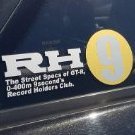Announcements
-
Similar Content
-
Latest Posts
-
There are a few variables here, some are relevant but not critical (IMHO) to help answer your question. The two major things: 1) Ignoring anything to do with forced induction - all engines have their own natural torque curve, and it will ALWAYS roll over higher in the rpm. There is a fixed relationship between power and torque. When dealing with kw and nm, the relationship between them is roughly: kw = (rpm * nm) / 9549 nm = (kw / rpm) * 9549 The peak torque of an engine (without boost) will typically climb until somewhere nearish the middle of it's operating rev range, give or take a bit - then start dropping again. The nearer the minimum and maximum rpm of the engine the steeper that drop off tends to be. 2) Boost simply increases the density of the air going into the engine, which inflates the torque at that point. The ramp up in the torque curve you see on a turbo engine is due to the boost rising, but it's essentially just multiplying the torque you'd see if it was naturally aspirated. The roll over you see at the end will typically be what would have always happened with the engine, whether it was naturally aspirated or turbocharged. If the torque never started dropping then power would climb infinitely. The cool thing about this is you absolutely can tune the power delivery to suit the needs of the owner and/or the limitations of the car, and I regularly do this. With modern turbos we've got to the point where a setup that someone may run well over 20psi of boost with could actually reach target boost well under 4000rpm if the tuner/owner WANTED to - and a lot of people seem to do this when there is actually no realistic benefit, generally it just adds a massive amount of strain to the engine and drivetrain and often actually makes the car harder to drive. As a general rule I tend to tune the boost curves for cars I tune to reach a "useful" torque level through the rev range and will often end up with a curve that ramps hard to a point, then creeps for the rest of the rev range - not to make the boost curve "soft" as such, but more to make sure its neither laggy nor pointlessly violent in it's delivery. There have been cars I've tuned to be almost like a centrifugal supercharger (or naturally-aspirated-ish) where they actually only hit like 8psi of boost before opening the gate, then ramp up the next 10psi over the rev range... if the car is "loose enough" to drive. On the flip side I've tuned a car that had stock cams and the engine's natural torque curve fell over HARD in the higher rpm and resulted in a slightly awkward power curve to work with, in that case I actually started ramping up boost to boost torque in a way to offset the engines "NA" torque drop off... at peak rpm actually running a good 5psi+ more boost that what the "flat curve" would have defined. This gave the owner an extra 500rpm or so of useable rev range, and had a fairly solid impact on times he was running at motorsport events due to being able to hold gears a bit longer and also falling into a more useful part of the rev range in the following gears. Here's an example of an RB in a GTSt I've done the "softened" boost curve to not pointlessly ramp straight to the max boost target early in the rpm, but still made sure it builds useful boost. If you went in the car you'd not guess at all that the boost curve was doing anything "weird", it feels like it spools immediately and accelerates relentlessly (traction dependent) and holds to max rpm. I don't know if you'd guess what the boost curve was doing by driving the car, or even looking at the dyno plot... but imho it suits the combination.
-
therefore on the first examples, as we see, changing cams (graph 2) influences the quantity of torque at high revs its OK for me. so a tuner can act on the wastegate via the boost controller to increase the boost at high revs? on the last example, the boost does not decrease ok, but the torque does. this can come from cams etc etc ok. but on the other curves the boost is not constant, it increases, this is what I find strange to my mind. even more so if it comes from the relief valve. sorry I'm very new don't blame me. in my mind I couldn't imagine how the boost could be higher after the spool
-
right, but fundamentally, for a given mechanical setup, you are either using all the torque (and therefore power) it will give, or you are choosing to run it less efficiently. Many tuners will have a practice of identifying peak available torque and then winding it back a couple of % for safety, but unless you are working around a very specific issue like a weak gearbox, there is nothing to be gained by making 20 or 30% less than the engine can
-
By Dose Pipe Sutututu · Posted
You can manipulate the torque delivery by ramping in boost gently, then throwing it all in after peak torque to keep the torque flat. It's nothing magical. -
Tuning the wastegate to do it. That is all. Most people want the boost to not fall off like the most recent example. Those also look like dyno runs with an Auto/Torque converter setup, which does fun things to the graph. The boost tapers down like that because the turbo cannot supply the same amount of air at 7000rpm that it can at 3000 in terms of PSI. That, or the tuner has decided that it tapering off like that is what someone chose to do. IF you have a wastegate that can't bleed enough air to slow the turbine, and IF that turbo can flow enough air to feed the engine at high RPM, you get 'boost creep' which is a rise of boost pressure beyond what you are capable of controlling and/or want. None of these show symptoms of that, but if you had a run that was 20psi at 3000rpm, and 27psi at 7000rpm, it could be an example of that. Or simply that the person wanted boost later for their own reasons... The dyno graphs don't always show the full context.
-









Recommended Posts
Create an account or sign in to comment
You need to be a member in order to leave a comment
Create an account
Sign up for a new account in our community. It's easy!
Register a new accountSign in
Already have an account? Sign in here.
Sign In Now